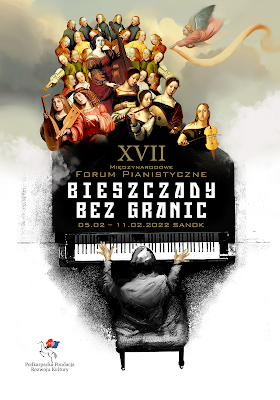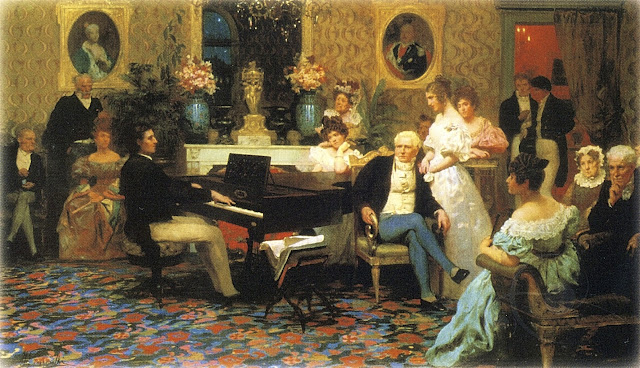Elisey Mysin recital - XVII International Piano Forum - Bieszczady Without Borders - Sanok, Poland
Astounding musical experiences always happen in Poland! Has been happening to me for as I long as I began visiting the country to work in 1992.
The astonishing recital by the child prodigy Elisey Mysin I watched online last night prompted me to write this review immediately. It was broadcast from the International Piano Forum, a Polish musical event now in its seventeenth year. The Forum (lectures and concerts) is held in the town of Sanok (the 'capital' of the remote Bieszczady Region). I knew or know nothing about this remarkable Forum until last night.
The concert was 'In Memoriam Tatiana Shebanova', that magnificent Russian pianist who died so tragically of leukemia in 2011 whilst at her pianistic peak. The concert was organized by her husband, the Chairman of the Piano Forum Council, Prof. Jarosław Drzewiecki.
They express deep nostalgia for childhood through the eyes of an adult. The titles are merely afterthought suggestions to the pianist (this according to Schumann).
Not only did Mysin possess the astonishing physical dexterity required for a commanding performance of the work but also the sine qua non when judging prodigious talent, the sensitive, poetic and deep expressiveness of a true musical 'genius' (in its original meaning as the depiction of a person’s unique personality and disposition). I felt the emotional expression and interpretation came organically from within and not simply imitated from his Professor as is so often the case in the flowering of precocious keyboard talents. Also I found his tone, touch and sense of piano colour, dynamic control, pedaling (feet just reaching the pedals!) and articulation bewitching and radiant at once. He also composes music which was clear from his deep understanding of the harmonic transitions within this work. Quite wonderful.
The Chopin Mazurka Op.6 No 1 in F-sharp minor and Mazurka Op.7 No.2 in A minor were brimming with idiomatic expressive nostalgic emotion and expressiveness in addition to superb natural organic phrasing and rubato. I felt him magically in touch with the inaccessible spiritual aspect of Chopin, that particular depth that escapes so many fine pianists. This was also present in the marvelous, deeply expressive performance of the Impromptu No.3 in D-flat major. The musical maturity displayed here was something to treasure and marvel at in one so young. His face carries such maturity and is transformed with concentration when he encounters the keyboard. The Chopin Waltz in A minor Op.34 No.2 displayed all the qualities of a natural Chopin interpreter. Would he have the ability and courage to play the next waltz that I automatically anticipated in my inner ear? Yes! This was followed by a glittering style brillante Waltz in F major Op.34 No.2 spectacularly authoritative in one so young.
Astonishingly he then embarked on two daring and breathtaking pieces by Maurycy Moszkowski - Guitare Op. 45 No. 2 and a dazzling performance of the Tarantella Op.77 No.6, where one could not help but marvel at the virtuosic articulation of the repeated notes (that hammering 'd') by an 11 year old! Complete natural musicality. And then, just in case we thought he was not in touch with the joy of youth and liveliness, the ragtime Golliwogg's Cakewalk from the Debussy Children's Corner Suite. Such dynamic contrasts were evident but I hope he mercifully he does not know of the significance of the Wagner reference yet!
His playing has such delight in making music, joyfulness and innocence it took years off my life and all those woebegone reflections of maturity. Hopefully he will retain these unblemished childhood qualities under the 'pressure of the modern' for many years to come.
Do watch this miracle and reflect : https://www.youtube.com/watch?v=8aSzUyCeqUY
Oh how I wish I had been there!
His recital was followed by an excellent recital by his Professor and pianist, Natalia Trull. She played fine Beethoven 6 Bagatelles Op.126 and an absolutely brilliant Petrushka by Stravinsky.
* * * * * * * * * *
I recently reviewed in detail a complete set of Chopin recordings by Tatiana Shebanova, immortally performed on an Erard instrument of 1849 and issued by the National Chopin Institute. A musical and interpretative revelation.
http://www.michael-moran.com/2021/05/tatiana-shebanova-was-one-of-first.html
* * * * * * * * * *
 |
| One of the beautiful wooden formerly Orthodox (now Roman Catholic) churches in the remote Bieszczady region of S-E Poland |
The Bieszczady region is the
Clouds settle in the dark green valleys and
stream through the pines in scenes of Wagnerian majesty. We are heading towards
our isolated accommodation called Leśny
Dwór (Forest Manor) in the remote
‘Psiakrew!’ [‘Dog’s blood!’]
‘W mordę jeża!’ [‘Into the hedgehog’s snout!’]
‘Wiwat!’ [‘Hooray!’]
I swing round to see an exuberant figure in a bushy ginger beard, calf-length battered green cords, walking boots and socks, check lumberjack shirt and braces welcoming us in rather old-fashioned but delightful bucolic Polish. He seems the perfect embodiment of a seventeenth century szlachta. I presumed he was the owner but he denied it with an equally exuberant and punched out
‘I do a few odd jobs around the place!’
before wrenching my bags from my hands and carrying them up the flights of stairs to my warm timbered rooms in the attic. Tiny dormer windows opened onto a spectacular pine-clad mountain vista. Here was a family dwór of the old type with a drawing room and piano, veranda opening onto the garden, library and operatic arias playing softly in the background. I suspect the owner of the manor was a member of the intelligentsia who like many artists, writers and musicians adopted the notorious ‘internal emigration’ from the constraints of the communist regime years before.
In the morning the summer rains began to clear and I decided to climb to the połonia, grasslands bare of trees that form the characteristic ‘peaks’ of the low mountain ranges of the Bieszczady. The climb to the Połonia Caryńska was muddy and slippery with two dark and gloomy sections needing a tiring heave up steep log steps through belts of fir trees. As the tree-line was passed the vista was breathtaking, the fields covered in mauve wildflowers, the grass of the połonia long, delicate and a beautiful shade of pale gold, exquisite in the sun, undulating slowly like the hair of a lover. But dark clouds soon began to rush along the valleys and obscure the peaks. I descended quickly rather than get caught in the violent storms that can suddenly envelop these mountains and reached the car just as a howling downpour began. Rum and coffee in a log cabin with a roaring fire (even in summer) and Poles singing rousing rustic songs lifted my spirits and warmed my aching body.
The Historical Museum in Sanok has one of the greatest collections of Russian Orthodox and Greek Catholic icons in the world - some 700 with other liturgical exhibits. I spent hours of artistic, religious and aesthetic contemplation there.
[1] The Boykos are a
(Extracted from A Country in the Moon: Travels in Search of the Heart of Poland Michael Moran, London 2008)
 |
| Sanok |






Comments
Post a Comment